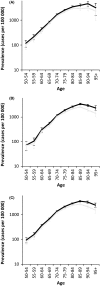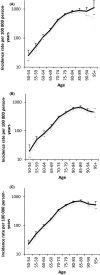Parkinson's disease in Germany: prevalence and incidence based on health claims data
- PMID: 27726128
- PMCID: PMC5655709
- DOI: 10.1111/ane.12694
Parkinson's disease in Germany: prevalence and incidence based on health claims data
Abstract
Background: In Germany, epidemiological information on Parkinson's disease (PD) is rare and outdated. Considering aging populations, current prevalences and incidence rates about this age-related disease would be important for adequate public health planning.
Methods: We used newly available health claims data sets from the largest German health insurer dating 2004-2007 and 2007-2010 with an analysis population in the base years of 491 038 persons aged 50 and older. Quarter-specific information about ICD-10 diagnoses and PD drug prescriptions from the inpatient and outpatient sectors was used to validate PD cases. Estimations were presented for two validation strategies relying on repeated PD diagnoses (SIa) and on one PD diagnosis followed by at least one PD drug prescription (SIb).
Results: The standardized prevalence was 797 (SIb) to 961/100 000 persons (SIa), showing an age-specific increase up to category 85-89 and a decline thereafter. The standardized incidence rate was 192 to 229/100 000 person-years with a similar age-specific shape. Prevalences and incidences rates were higher for men compared to women in regard to age.
Conclusions: Health claims data are found to be suitable for PD assessment using the repeated diagnoses or PD drug prescriptions as necessary criteria.
Keywords: Parkinson's disease; health claims data; incidence; prevalence.
© 2016 The Authors. Acta Neurologica Scandinavica Published by John Wiley & Sons Ltd.
Figures




References
-
- von Campenhausen S, Bornschein B, Wick R, et al. Prevalence and incidence of Parkinson's disease in Europe. Eur Neuropsychopharmacol. 2005;15:473–490. - PubMed
-
- Bach JP, Ziegler U, Deuschl G, Dodel R, Doblhammer‐Reiter G. Projected numbers of people with movement disorders in the years 2030 and 2050. Mov Disord. 2011;26:2286–2290. - PubMed
-
- Kis B, Schrag A, Ben‐Shlomo Y, et al. Novel three‐stage ascertainment method Prevalence of PD and parkinsonism in South Tyrol, Italy. Neurology. 2002;58:1820–1825. - PubMed
-
- Benito‐León J, Bermejo‐Pareja F, Rodríguez J, Molina J‐A, Gabriel R, Morales J‐M. Prevalence of PD and other types of parkinsonism in three elderly populations of central Spain. Mov Disord. 2003;18:267–274. - PubMed
-
- Chan D, Cordato D, Karr M, et al. Prevalence of Parkinson's disease in Sydney. Acta Neurol Scand. 2005;111:7–11. - PubMed
MeSH terms
Substances
LinkOut - more resources
Full Text Sources
Other Literature Sources
Medical

